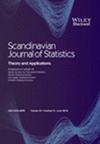在超样本嵌套病例对照和病例队列研究中使用多重输入
IF 1
4区 数学
Q3 STATISTICS & PROBABILITY
引用次数: 0
摘要
当一些协变量测量成本较高时,巢式病例对照和病例队列研究对于研究协变量与时间到事件之间的关联是有用的。完整的协变量信息仅在嵌套的病例-对照或病例-队列样本中收集,而廉价测量的协变量通常在整个队列中观察到。这种病例对照样本的标准分析忽略了任何完整的队列数据。先前的研究表明,通过对昂贵的协变量进行多重输入,然后进行全队列分析,可以有效地利用全队列的数据。对于大型队列来说,这在计算上是昂贵的,甚至是不可行的。另一种方法是用额外的控制来补充病例对照样本,这些控制可以观察到廉价测量的协变量。我们展示了多重插值如何用于分析这种超采样数据。模拟表明,与传统分析相比,这带来了效率的提高,而与使用完整队列数据相比,效率的损失并不大。本文章由计算机程序翻译,如有差异,请以英文原文为准。
Use of multiple imputation in supersampled nested case‐control and case‐cohort studies
Nested case‐control and case‐cohort studies are useful for studying associations between covariates and time‐to‐event when some covariates are expensive to measure. Full covariate information is collected in the nested case‐control or case‐cohort sample only, while cheaply measured covariates are often observed for the full cohort. Standard analysis of such case‐control samples ignores any full cohort data. Previous work has shown how data for the full cohort can be used efficiently by multiple imputation of the expensive covariate(s), followed by a full‐cohort analysis. For large cohorts this is computationally expensive or even infeasible. An alternative is to supplement the case‐control samples with additional controls on which cheaply measured covariates are observed. We show how multiple imputation can be used for analysis of such supersampled data. Simulations show that this brings efficiency gains relative to a traditional analysis and that the efficiency loss relative to using the full cohort data is not substantial.
求助全文
通过发布文献求助,成功后即可免费获取论文全文。
去求助
来源期刊

Scandinavian Journal of Statistics
数学-统计学与概率论
CiteScore
1.80
自引率
0.00%
发文量
61
审稿时长
6-12 weeks
期刊介绍:
The Scandinavian Journal of Statistics is internationally recognised as one of the leading statistical journals in the world. It was founded in 1974 by four Scandinavian statistical societies. Today more than eighty per cent of the manuscripts are submitted from outside Scandinavia.
It is an international journal devoted to reporting significant and innovative original contributions to statistical methodology, both theory and applications.
The journal specializes in statistical modelling showing particular appreciation of the underlying substantive research problems.
The emergence of specialized methods for analysing longitudinal and spatial data is just one example of an area of important methodological development in which the Scandinavian Journal of Statistics has a particular niche.
 求助内容:
求助内容: 应助结果提醒方式:
应助结果提醒方式:


